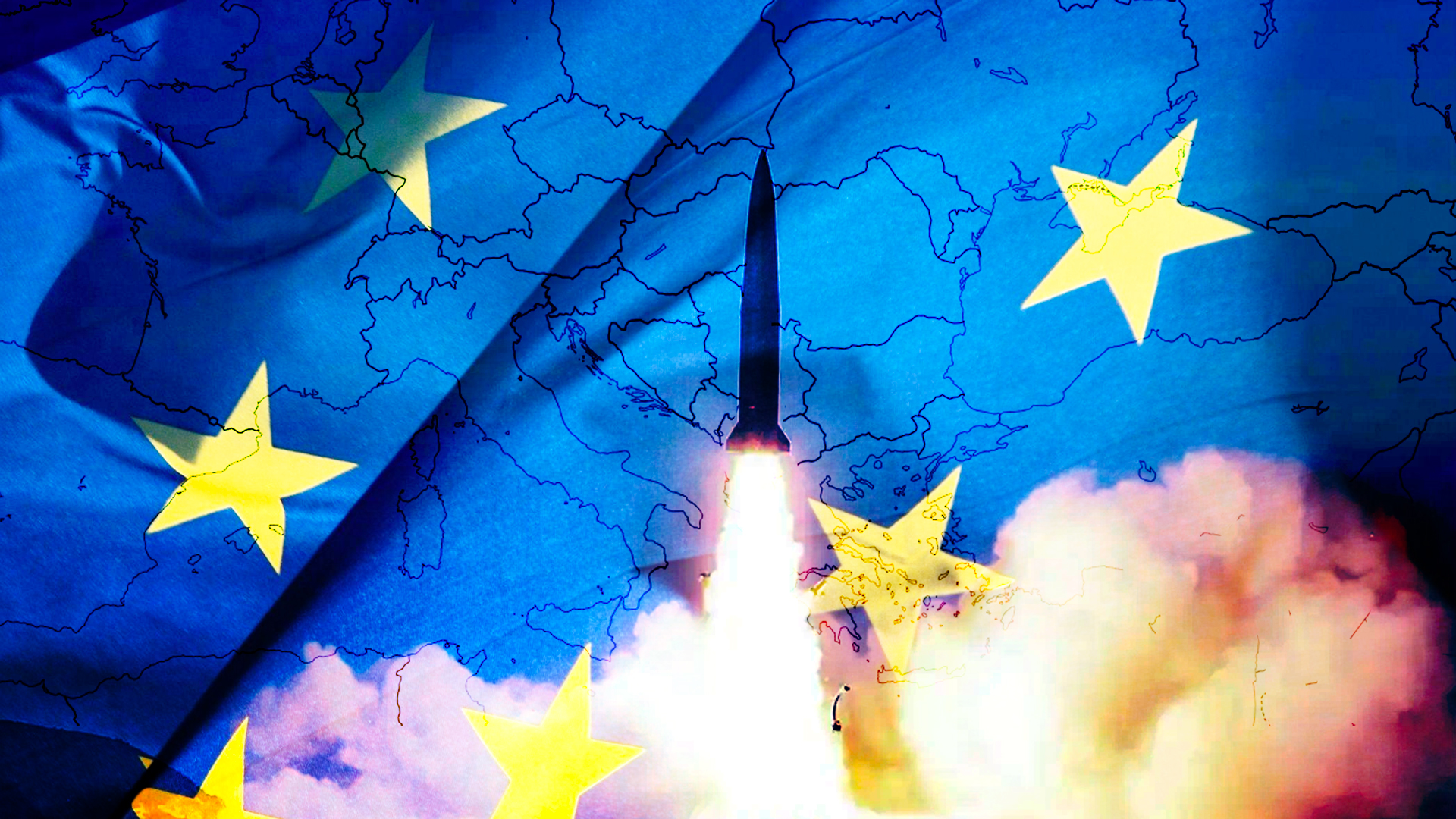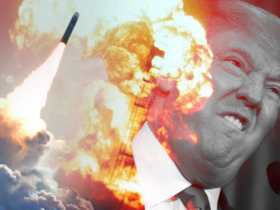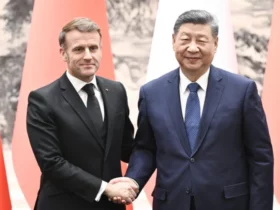The Second World War was finally coming to an end. The US President Truman has told the Soviet leader Joseph Stalin through a Russian translator, that they have developed and successfully tested “a new weapon of unusual destructive force”, during the conference at the Cecilienhof Palace in Potsdam, Germany, on July 24th 1945. Exactly 13 days after that conference was held, the United States dropped the first nuclear bomb over the city of Hiroshima, Japan. However, this weapon was not needed to be used. Japan was already preparing to surrender. Admiral William D. Leahy, who has served as the Chief of Staff during the Roosevelt and Truman eras, have said that: ‘ My own feeling was that in being the first to use it, we had adopted an ethical standard common to the barbarians of the Dark Ages. I was not taught to make wars in that fashion, and that wars cannot be won by destroying women and children.’. And the Admiral King, commander of the US Navy at the time, said that “The use of the atomic bomb would not do any tangible gain at all.”. And the British strategist B.H. Liddell Hart said that “dropping of the atomic bombs was completely unnecessary.”
Then why was that bomb dropped and why that atrocity was even committed in the first place? The real reason behind it, was to tell the Soviets to stop. The strategic nuclear weapons developed by the American and Soviet arms industries after the 1950s as the part of a great competition, have reached a level that would change the world’s entire course and destiny for many centuries. More than 2000 nuclear tests have been made since 1945, but none of them were ever used on the battlefield. The closest risk for a nuclear weapon to be used in history, have occurred during the Cold War in 1962 the Cuban Missile crisis, but even then, they were not used. It was only after this crisis, that we have learned that Jupiter missiles with nuclear warheads were stationed on our lands.
THE ATTEMPTS TO STOP THE NUCLEAR ARMS RACE
In order to put an end to this race, SALT (Strategic Arms Limitation Talks) which put a limit to the nuclear arming, began in the 1970s. The US President Ronald Reagan has started the START (Strategic Arms Reduction Talks) with the USSR in the 1980s by saying that this limitation would not be enough and that serious reductions should be made. At this point, both sides had approximately 8000 strategic nuclear warheads. These were mainly Intercontinental Ballistic Missiles (ICBMs) stationed at on land-based silos; SLBM missiles stationed in nuclear-powered ballistic missile submarines (SSBN), and the strategic nuclear bombs carried by the bomber wings under the control of the Strategic Air Command (SAC). The firepower triangle formed by these three main elements, were called the “Strategic Triad”. The short paradigm of the military doctrine which was provided with a balance of terror by the nuclear deterrents, was called “Mutually Assured Destruction or MAD” during this period. Let us also note that the most critical element in this triangle, were the nuclear submarines because of their ability of a second strike. And so far, the United States had spent 5 trillion dollars on nuclear arming.
TOMAHAWKS HAVE A CONVENTIONAL DETERRENT ROLE
The initial employment of the Tomahawk cruise missiles in the US arsenal in 1991, when the Cold War ended, constituted the second most effective weapon system for the American hegemony, after the nuclear weapons. They only allowed the UK to have this weapon system, except for themselves (and Japan later on). This weapon system and the American aircraft carrier strike groups, had become the most effective instrument, bringing blood and tears to the Afro-Eurasian geography from Iraq to Syria and from Afghanistan to Libya, as a part of the post-Cold War US strategy of creative chaos and of and global bullying. And now it was time for the global bullying by the conventional weapons.
INF-INRETMEDIATE RANGE NUCLEAR FORCES TREATY
In addition to strategic nuclear missiles, there were also the intermediate-range ballistic missiles and cruise missiles, with the range of 500-5500 kilometers. These missiles, which were called the IRBMs, were banned after the INF (Intermediate-Range Nuclear Forces) Treaty in 1987 during the Reagan -Gorbachev eras, right before the end of the Cold War. 2692 missiles were mutually deactivated until 1991. Pershing II missiles, which were planned to be deployed to Europe, have been withdrawn from service. Europe has reduced its nuclear risk at the final moment.
START TALKS
The START talks with the aim of reducing the strategic nuclear weapons this time, has accelerated with the success of the INF Treaty at the end of the Cold War. The START I has been signed in 1991; and the START II agreement has been signed in 1992. But the START II agreement was not ratified in the Russian Duma even when the year was 2001. That was because the United States has withdrawn from the 1972 ABM (Anti-Ballistic Missile) Treaty due to its the Ballistic Missile Defense project. Therefore, the START III negotiations began during the Clinton-Yeltsin era. The aim of this agreement was to downsize the number of the warheads from 3000 to 2500 for both sides. With the New START agreement signed under the Obama-Medvedev leaderships, this number was decided to be reduce to 500-1000 nuclear warheads, and to 1500-1675 launchers. But the course of the history was coming up with new circumstances.
THE BALLISTIC MISSILE DEFENSE BEGINS
The Russian Federation has announced in its Military Doctrine, which was approved on February 5th 2010, after the Georgian-South Ossetian War on August 8th 2008, that nuclear weapons could be used when the national interests were at stake at point of survival, or in the face of a threat of a major conventional conflict. This incident has accelerated that initiative of the United States and NATO, which was known as the Ballistic Missile Defense (BMD). This led to the deployment of both X-Band radars (such as in Kurecik, Malatya) and the SM-3 missile systems (such as in Devesul, Romania). But both sides still announced that they would follow the agreement after START III, which came into force on February 5th, 2011. With this agreement the parties were expected to only deploy 700 ICBM or SLBM missiles, and nuclear devices on bombers, and a total of 1550 nuclear warheads and with 800 launchers for all the weapon systems. However, this agreement was never fully reached. And that agreement never came into effect. In March 2013, Russia claimed that the United States was forging with their numbers.
THE COUNTERACTION BY THE US
It has been five years since then. And the US Nuclear Posture Review (NPR), which was announced on February 2nd, 2018, has further complicated the current situation. Because in that review, the Trump Administration had aimed to boost the national nuclear capabilities. And this would require another 1.2 trillion dollars, for the rearming over the next 30 years. The most crucial thing with these armaments, was the introduction of cruise missiles (SLCMs) in nuclear attack submarines (SSN), and new types of ballistic missiles fired from SSBNs with lower-yield nuclear warheads. The US Navy once had nuclear-armed Tomahawk missiles during George W. Bush administration, but those missiles were deactivated, because of the risk in case one of them accidentally detonates over Japan or South Korea. Now we can understand the Pentagon’s ambition on making more advanced technologies, under the pretext of Russia, North Korea, Iran, or China. It was pretty clear that this situation would cause some mutual false alarms. Because no one can guarantee that Russia or China will not retaliate with a nuclear ballistic missile, against the potential for a possible nuclear Tomahawk missile fired from an American submarine. Because even the lowest yield of these missiles, would have hundreds of times more impact than the one dropped on Hiroshima. Consequently, on January 28th, 2019, the US National Nuclear Security Administration (NNSA) has announced the start of the production of a lower-yield nuclear warhead (W76-2) for the Trident missiles which were again to be fired from ballistic missile submarines, SSBNs. Let us also say that the destructive force of these new missiles, reportedly to be equivalent to one third of the nuclear bomb which were dropped on Hiroshima. The simple assumption by the American government circles, is that the war could be won by the tactical nuclear weapons, without even taking one level up to a strategic level. This is an extremely dangerous step. Because there would be a confusion on the firepower of the missiles which are fired from the SSBNs and from the SSNs. It is very difficult to tell the difference between the launch of a cruise missile like the Tomahawk and the launch of a strategic ballistic missile. So, the risk of retaliation to a conventional attack with a nuclear attack is very high.
THE US WITHDRAWS FROM INF
In 2019, Putin declared that they wanted to comply to the START III agreement. And on January 17th, 2019 the Russian Foreign Affairs Minister Lavrov said that there were not any positive feedbacks from the United States, despite all their positive efforts. On August 2nd, 2019 a very unusual action came from the United States. They officially announced that they withdrew from the INF treaty, which they have signed in 1987. This was a major blow to the global peace and stability. Trump announced that they would start the withdrawal process in February 2019, and that the withdrawal would be completed within 6 months unless Russia deactivates their 9M729 intermediate-range nuclear missiles, which creates an infringement. While the main reason for the US to withdraw was the Russian missiles which exceeded the 500-kilometer range limit and their tests still being conducted, the main reason for Russia’s missile deployment was the activation of the Aegis ABM missile systems to Romania and to Poland. But the actual reason for this decision, was the INF treaty disabling the United States to act against China in the Pacific region indirectly, if not directly. The United States was taking an action against China, however showing Russia as the excuse. Russia had already declared that their missiles were under the 500-kilometer range limit. An important offer came from the Russian side on April 27th, 2020 for the strategic weapon systems out of INF Treaty. “Given that the START-III agreement will expire in less than a year, and that the new types of weapon systems were developed, we are ready to negotiate the aforementioned types pf weapon systems outside the extent of the START-III agreement.” The United States rejected the offer.
THE NUCLEAR CUL DE SAC
Sergey Rogov, the President of the US and Canadian Institutes of the Russian Academy of Sciences, has made the following comments on the increasing risk of a nuclear war, due to the recent actions of the Donald Trump administration, on May 6th, 2020: “The United States has demanded China to be a signatory of this process as well, but this does not seem to be possible in any way. The START-III is now the only agreement to limit the nuclear weapons, after the US withdrew from the Intermediate-Range Nuclear Forces Treaty (INF). If that treaty is also broken, all military tensions, including the threat of nuclear war, will rise sharply.” Both sides continued to row against the tide. The two sides met in Vienna in July 2020. The United States has also invited China to the negotiations. But China did not participate. On September 27th, 2020 the US Deputy Secretary of State Stephen Biegun said that both Moscow and Washington wanted to prolong the START III Agreement, but the circumstances under which this agreement would be signed, still remains as a question. In October 2020, Putin offered to extend the date of the current START agreement for at least another year, the United States rejected, but they counteroffered the banning of the new warheads production, for at least one year. Russia has agreed to this term.
REJECTING THE RUSSIAN OFFER
On October 26th, 2020 Putin defined the US withdrawal from the INF agreement as a serious mistake. He offered a pause of production and conducting mutual inspections, by guaranteeing that Russia will not deploy any missiles near the border to NATO countries, as long as the United States is not to deploy similar missiles on the borders to Russia. This offer was not accepted by neither the NATO Secretary-General, nor by the governments of the West. NATO Secretary-General said that “The nuclear weapons play a vital role in keeping the peace.” as a response to that offer.
ALLEGATIONS ON IRBM MISSILE FOR ITALY
And last but not least, American arms giant Lockheed Martin has received an order worth of 340 million dollars from the US Army, on November 6th, 2020. And what was the order in question? They were these SM-6 missiles, to be deployed in Europe. The Italian academic at the Center for Research on Globalization Manlio Dinucci, claims that this deployment will take place in the island of Sicily in the near future. He notes that if such thing ever happens, Italy will become a subject to the US, this time by IRBM nuclear missiles, in addition to the American nuclear missiles in the Italian Air Force arsenal. He notes that Russia can only hit the United States with the strategic nuclear missiles, while they can hit Europe with IRBMs, with much shorter ranges, and in fact Europe is actually being threatened by the United States instead of Russia.
LESSONS FOR TURKEY
Let us make a quick reminder for Turkey. The B61 bombs equipped by the Turkish bomber planes in Incirlik Air Base, actually have no good use for Turkey. However, it makes Turkey, a viable and clear target for Russia in the potential nuclear war. These weapons, which Turkey has no authority to use at all, must be reevaluated in the near future. As some people in the United States also repeatedly emphasized, it would be also very convenient for us to let them move to Crete.
USING NUCLEAR WEAPONS IS A CRIME AGAINST HUMANITY
Today, nature is in a very delicate balance due to both increasing carbon emissions and the thinning of the ozone layer as a consequence of it. Any country that uses a nuclear weapon, will further break this delicate balance and accelerate the process of global extinction. When a nuclear weapon is detonated, a blast from the explosion, a thermal radiation, and a nuclear radiation occurs. For a nuclear device with a yield in Kilotons (KT) (equivalent to on thousand tons of dynamite exploding), the share of these energies emitted is, 50%, 35%, and 15%, respectively. The bomb dropped on Hiroshima had a yield of 15 KT (15,000 tons of dynamite exploding). A nuclear bomb with such power would cause some sudden deaths in an area within 3.5 kilometer range; and a 550 KT nuclear bomb within 9 kilometer range, with their blasts reaching a speed of 800 km/h, and a thermal radiation. But in the long-term, this does a slower harm than a sudden destruction. The fireball of the explosion, which has a temperature in thousands of Celsius for a nuclear yield in Kiloton (KT), and millions Celsius for a nuclear yield in Megatons (MT); evaporates and makes everything in the area vanish and evaporates it into the atmosphere as little particles, within a range of few hundred meters at the nuclear yields in Kilotons (KT), and around 1 km radius at the nuclear yields in Megatons (MT). These particles cause a great damage to the human and natural life in the long-term. These particles carry radiation to the regions far from the ground zero and to a wide region as a long-term destructive effect, which results in a nuclear fallout.
THE GREATEST THREAT: NUCLEAR FALLOUT
The nuclear fallout starts to form in the atmosphere, 24 hours after the explosion. While the smaller particles float freely in the stratosphere around the globe, the larger particles are spread as local fallout, in the areas closer to the surface. It is exactly this point, where we can say that nuclear weapons will not bring a peaceful victory to the winner either. Because you can never get rid of the global nuclear fallout. Those who think they have survived, get cancer due to the hidden damage to their DNA, their metabolism, and to their reproductive systems, in the long term. Studies made on the ice shelves in Antarctica over the past 40 years, have identified traces of the nuclear tests done by France, many years ago in the French Polynesia in the middle of the Pacific Ocean. That research was made 10,000 kilometers away from the nuclear testing site. Another long-term effect of the nuclear fallout is the damage made on the global climate. One thing would be the global cool down due to the nuclear dust clouds that will block the sun from reaching the earth; and the other would be the increase in ultraviolet radiation due to the weakening of the ozone layer, causing a great damage to life on earth. NASA has found that the 40% of the nuclear fallout after a major nuclear detonation, will remain in the stratosphere for around 10 years. This means that even the power of only 1% of the global nuclear stockpile today, could send us to a nuclear dark age. A nuclear device equal to the yield of 100 times that of the atomic bomb dropped on Hiroshima (1.5 Megatons), being detonated over major cities, could create roughly 5 million tons of nuclear fallout particles in the stratosphere, which would cause the global average temperatures to return to another ice age. This would mean that over a billion people would starve to death only due to the nuclear winter. This means that a government using the nuclear weapons do not only kills the people, they would also kill the nature. And nature never forgives. The radiation generated by the 1,000-MW reactor that had a meltdown in Chernobyl on April 26th 1986, caused a nuclear fallout roughly equal to 100 times of that atomic bomb dropped on Hiroshima, even though it did not create any blast or a thermal radiation, unlike what a bomb would cause. The effects of it continue even to this day. The number of the cancer patients have doubled in Marmara Region, and tripled in the Black Sea Region in Turkey after 1986.
THE NUCLEAR THREAT INCREASES
The nuclear age started by the United States, neither brought peace and nor happiness to the world. On the contrary, the last 70 years, which began with the atomic bombing of Hiroshima, have been the most dangerous period of the 4000 years of recorded human history. During the Cold War, the earth has witnessed the nuclear stockpiles which could destroy the human civilization several times over which formed the very essence of the nuclear strategy as the balance of terror. Although this balance prevented a full-fledged conflict between NATO and the Warsaw Pact during the Cold War for half a century, it failed to prevent the proxy wars. At the beginning of the 1950s, there were two nuclear powers on Earth. Today nine countries have nuclear capabilities. What is worse, is that while the world’s resources are rapidly running out, the global population is growing exponentially. And we are entering such a period that the main principles that prevented the use of the nuclear weapons during the Cold War is starting to disappear. Was the US President Truman aware of the gloomy future he prepared to humanity, when ordered the use of this weapon on Hiroshima and Nagasaki?

















Leave a Reply